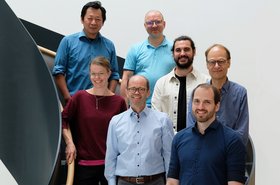Kick-off for the project "SPLASHH - Shaping Plasma Accelerators in Hanseatic City of Hamburg"
TU Hamburg, DESY and Fraunhofer IAPT aim to jointly advance the development of compact particle accelerators using 3D printing
25.08.2022

DESY, the Fraunhofer Institute for Additive Production Technologies IAPT and the Hamburg University of Technology are receiving funding for the "SPLASHH" project as part of the state innovation funding provided by the Hamburg Ministry of Science, Research, Equality and Districts. Under the slogan "Shaping Plasma Accelerators in Hanseatic City of Hamburg", the three project partners have set themselves the goal of jointly developing the technology for manufacturing compact accelerators. They will investigate the processing and quality assurance of innovative copper and sapphire glass materials using 3D additive and subtractive manufacturing. With a kick-off event at Start-up Labs Bahrenfeld, the project has now officially started and is running with a funding amount of 500,000 euros.
Further development of compact laser plasma accelerators
The project aims to solve key challenges of novel laser plasma acceleration. This is an innovative technology for a new generation of compact particle accelerators that differ fundamentally from conventional accelerators. In this process, electrons are accelerated very strongly over a distance of only a few centimeters in a sapphire platelet with the aid of a strong laser pulse and a plasma wave of hydrogen gas. "Laser plasma accelerators can achieve accelerations that are up to a thousand times higher than the most powerful machines in use today," explains Andreas R. Maier, DESY's chief scientist for lasers and secondary sources. "Another key advantage is the low-cost and compact design. One day, users will no longer have to come to the facility; we will bring the facility to them," he adds.
However, the novel technology of the plasma accelerator requires completely new design concepts and complex, high-precision component geometries to structure the plasma, much like today's modern accelerator modules must have specific shapes to perform their function. As a solution, the three project partners in "SPLASHH" want to use function-optimized components and participating technologies. Using powder bed-based laser melting, Fraunhofer IAPT is developing a 3D-printed copper holder. The TU Hamburg is contributing structured sapphire glass capillaries via the selective laser-induced etching (SLE) method. Finally, DESY takes care of the quality assurance of the components through its high-resolution synchrotron analytics, which allows to precisely understand and qualify the 3D printing process and the 3D component.
Providing impetus for 3D printing in the Hamburg metropolitan region
The project sets important impulses for the Hamburg metropolitan region to advance the industrialization of 3D printing towards a production-ready additive manufacturing technology. The technology of 3D printing allows many advantages such as the production of complex shapes and components with low material input. "We are pleased to lay the foundation for the further development of 3D printing and also for the networking of scientific institutions and industry in the Hamburg metropolitan region with the implementation of our joint project based on an exciting use case," says Nadja Kölpin, Industry Relations Manager, who is coordinating the project on DESY's part.
For the intended close integration of science and industry, the project was able to successfully win a circle of Hamburg companies from sectors such as manufacturing technology, materials production, biotechnology and the semiconductor industry as supporters in advance. These companies either support the project as competent industrial partners with their expertise or have already expressed concrete interest in the individual components of the technology.
TUHH - Public Relations Office







